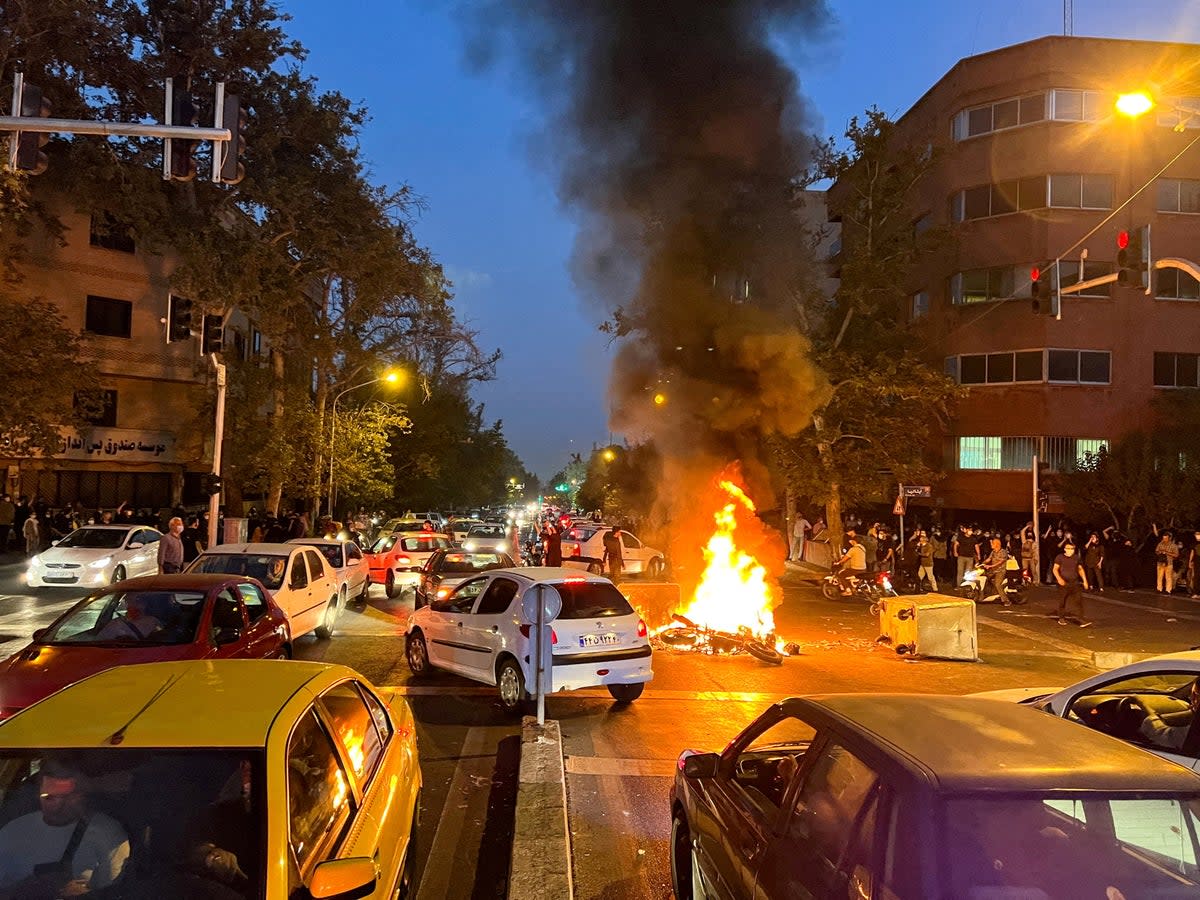‘Hit the b*****ds!’: Anti-regime protests continue to rage in Iran

In Shiraz, a lively street protest led by dancing youth Tuesday night turned grim after security forces allegedly opened fire, leaving behind at least one dead teen and turning parts of the historic city of poets into a war zone. In Tehran, regime enforcers stormed a metro station, shooting at and beating terrified protesters and passengers, including some who were aboard a subway car.
Across the country, central business districts were turned into ghost towns during the day by businesses adhering to general strike calls. Fires burned and fiery battles between protesters and security forces backed by pro-regime Basij militiamen raged into the early morning hours of Wednesday, when the mass uprising in Iran sparked by the death-in-custody of 22-year-old Mahsa Amini entered its third month.
“Ration-eating Basiji, it’s over! Eat up!” protesters in Rasht chanted as they threw rocks and set fires, according to video footage uploaded to the internet.
Though sparked by Amini’s arrest over her alleged violation of dress codes and her subsequent deaths, the protests have quickly become a widespread movement aimed at a possible dismantling of the Islamic Republic for its grim human rights record, lack of political freedoms, economic mismanagement and marginalisation of women and minorities.
“You’re the whore. You’re the weed,” said protesters in the small city of Avez, a county seat of less than 50,000 in Iran’s southwest, hurling insults at regime leaders. “I am a free woman.”
The protests, arguably the most formidable political challenge to the Islamic Republic in its 44 years of rule, have already left at least 344 people dead and led to the arrests of more than 15,000 people, according to Hrana, an Oslo-based human rights monitor.
Tehran officials said three security personnel were also killed on Tuesday. Two Revolutionary Guard members shot dead in separate incidents in Iran’s persistently volatile Kurdish region, and a member of the pro-regime Basij militia died of his injuries after being allegedly struck by a Molotov cocktail in Shiraz.
The ongoing surge of protests this week coincides with the third anniversary of a 2019 uprising by mostly poorer Iranians against rising prices that quickly took on an anti-regime tenor and was violently suppressed by the regime.
Informal leaders of the protest movement have called for three days of nationwide protests to mark the Aban protests, named after the Persian calendar month roughly coinciding with November, and a day of solidarity marches scheduled across the world scheduled for Saturday.
“It is clear by now that the protests are not going to die down anytime soon,” said Hamidreza Azizi, a researcher at the German Institute for International and Security Affairs, in Berlin. “There have been a lot of ebbs and flows we’ve seen some days with no major protests or much more limited ones. Exactly at the moment when people start thinking it’s the end, there’s a call, and people come to the streets in full force. “
The current surge of protests, breaking out in scores of cities and on the campuses of universities and secondary schools, is the most geographically and demographically diverse display of discontent with the regime in years, drawing rich and poor, urban and rural—though overwhelmingly led by youth.
“Hit them,” a man can be heard crying out in one video, as men side by side with women picked up and threw rocks at regime gunmen in Eqlid, a city of about 90,000 in southwestern. “Hit the bastards!”
In one leaked video, a regime enforcer named Pooyan Hosseinpour, warns a group of Basiji thugs that the protesters in the current uprising were not only more fearless but more prevalent.
“In the past we would attack and they would go. Or maybe they’d throw four rocks and we’d throw four rocks and then we’d throw something else and they would go,” he said in a clip dated about two weeks ago. “This time they stand firm for an hour and don’t leave. You enter a street and if there are 30 buildings, they throw rocks at you from 30 buildings. And not just rocks: flowerpots, irons, benches.”
Neither the regime nor the protesters appear ready to back down. The regime has upped the stake by threatening to use the impose the death penalty on captured protesters, who remain grimly defiant despite the hardships.
Mr Azizi described a prolonged confronation, with both sides digging infor a long fight.
“I have no work, and I have almost money,” one Tehran protester in his early 30s, said in a phone interview. “But in some ways I have never been so happy my whole life. The revolution is doing well, and the revolution will continue.”
One resident of the northern city of Rasht who sometimes joins the protests described a growing sense of affection and kindness among the strangers who gather together on the streets.
“There’s a lot of unity, and when we see each other, we help and support each other,” he said. “There are the Basiji and there are those on the side of the regime, and there are the people, and we are all together.”

